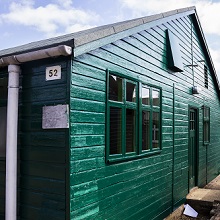Case Studies
Bletchley Park Regeneration
The story of Hut 8 – from state secret to national treasure.
As its name implies, structurally speaking, it's just a hut. It’s a single-storey wooden building with a pitched roof, sitting on a brick base in the grounds of a rather odd Victorian mansion, near a railway line in North Buckinghamshire.
But it’s not just any hut. It’s Hut 8 and it was here roughly 70 years ago that the fate of the world hung for several perilous months. Hut 8, a Grade 2 listed building, is a key part of the story of Bletchley Park. Under the leadership of the mathematical genius Alan Turing, teams of cryptographers working under conditions of absolute secrecy decoded German naval messages that had been intercepted.Bletchley Park, known as Station X, was probably the best-kept secret of the War. At its busiest, the house and its numerous outbuildings accommodated about 8,000 people working a three-shift pattern, 24 hours a day, 365 days a year. The site was chosen for its discreet location and because of its proximity to the Oxford to Cambridge railway line, which ensured an easy and ready supply of college-trained code breakers from the finest universities. The enemy had no idea that the place existed and the only bomb that ever fell on Bletchley Park was probably intended for the railway station.

No word of its activities ever leaked out until the publication in 1974 of a book about the Park finally began to lift the lid on what had happened there. The story is heroic and historic – teams of mathematicians, academics, chess players and puzzle solvers working day and night to develop the earliest of electronic computers that would help solve the riddles created by the enemy’s electro-mechanical coding machines. The work of the code breakers is credited with shortening the war by as much as two years and saving thousands of lives. Ironically, it was the cloak of secrecy that protected Bletchley Park during the war that most threatened its survival as a museum and heritage site in peace-time. Very few people had ever heard of Station X and those that had were still highly unwilling to talk about Bletchley Park long after the war was over.
Over the years, the fabric of many of the buildings – erected on a temporary basis at a time when materials and manpower were both scarce - grew steadily worse. In a bid to save the history of the location before it disappeared a programme of renovation began, and Rolton Group provided surveys and reports on the state of some of the buildings.
If anyone had bothered to think about it at the time, Hut 8 might perhaps have been expected to last about five or ten years. Hardly surprising at a time when no one knew if they were going to be around in five to ten years’ time.
Now, 70 years later, the brief for architects David Hartley Associates was to design and refurbish the building so that it could last for at least another 70 years. This time, however, Hut 8 had to be redesigned as a permanent structure, to comply with the demands of 21st century health and safety legislation and large numbers of visitors. The extra demand that Rolton’s structural engineers faced was that as a historic building, Hut 8’s final outward appearance had to match the way it had looked originally.
The first task, says Rolton Group’s Andy Chisem, Structural Director, was to make the building safe. An initial investigation revealed the full story of decline. Dry rot was eating away at the timbers, the brick foundation was crumbling, two gable ends had moved off their original supports and, structurally speaking, the roof trusses didn’t work. And then there was the asbestos – widely used in the thirties and forties when its carcinogenic properties weren’t understood, but now banned. The engineers drew up a programme to stabilise the building, design the remedial works and replace the asbestos with a look-alike product that was safe. Even the roof trusses, out of sight above the ceilings, were rebuilt in their original style.
Today Hut 8 is open to the public – an unthinkable idea 70 years on. Remarkably, there’s a real sense of touching history about the place. Stand by the spot where the great Alan Turing worked, and chained his tea mug to a cast iron radiator, and history seems like the day before yesterday. The transformation of Hut 8 from national secret to national treasure is now complete and forms a new chapter in the remarkable story of Station X and Bletchley Park.